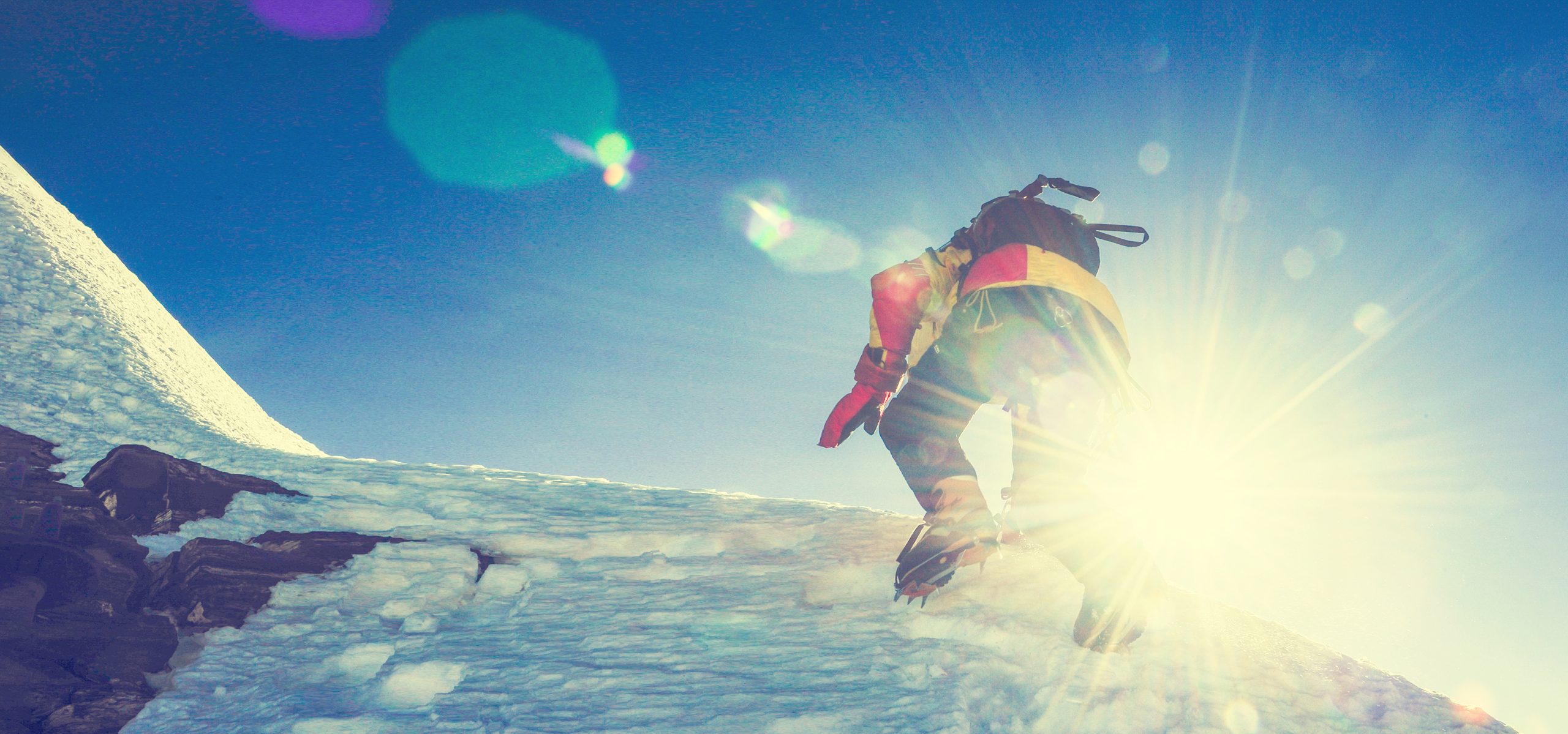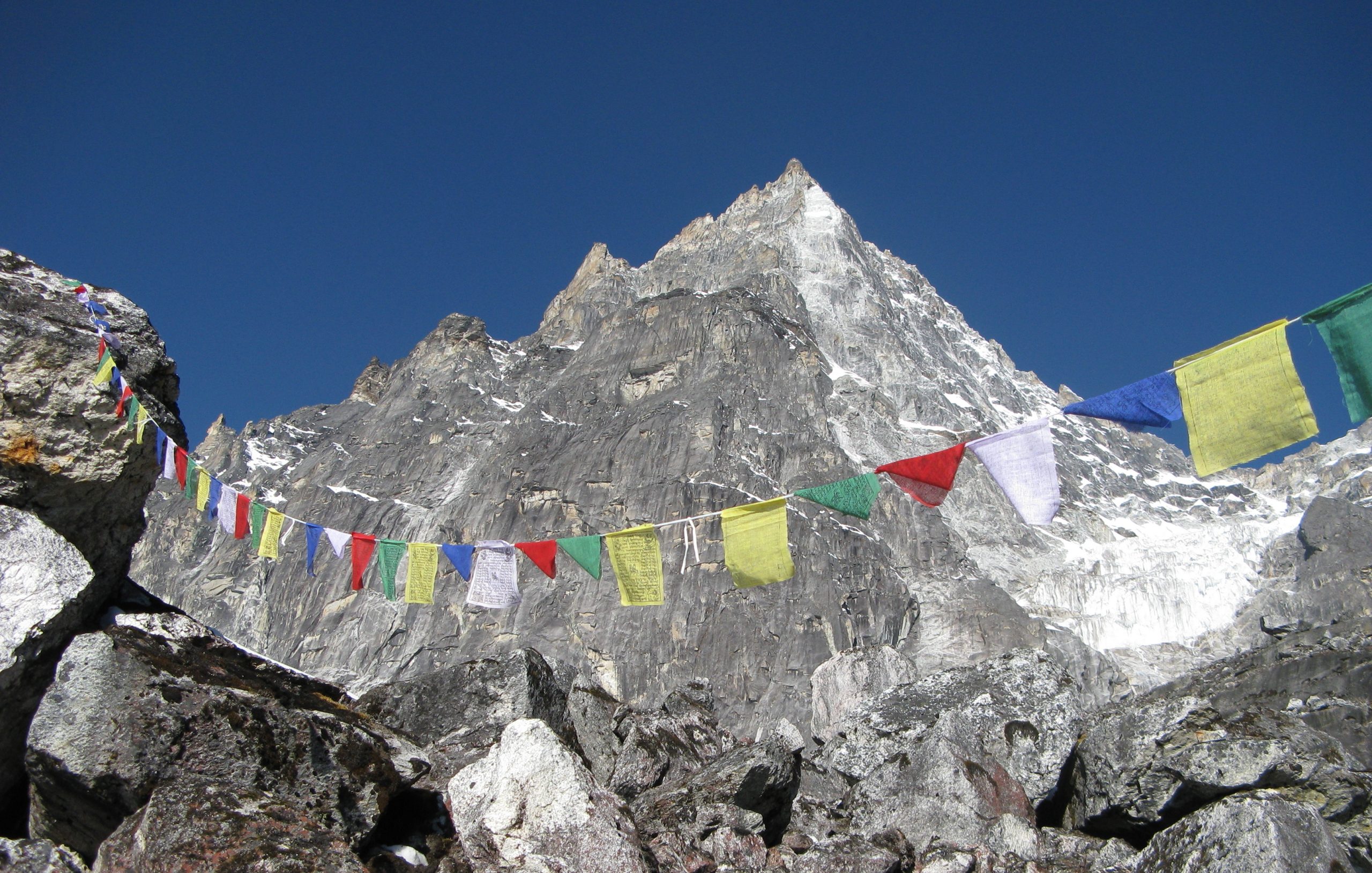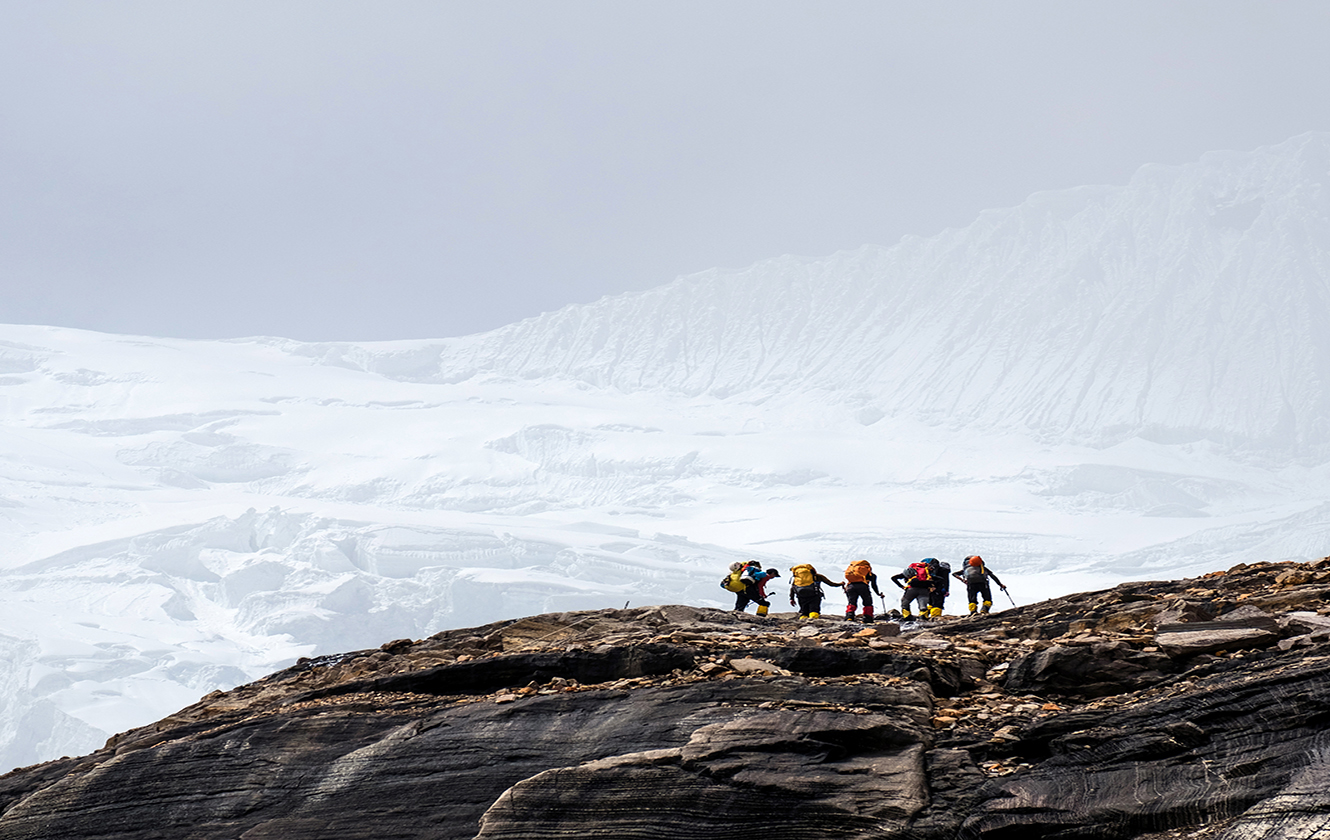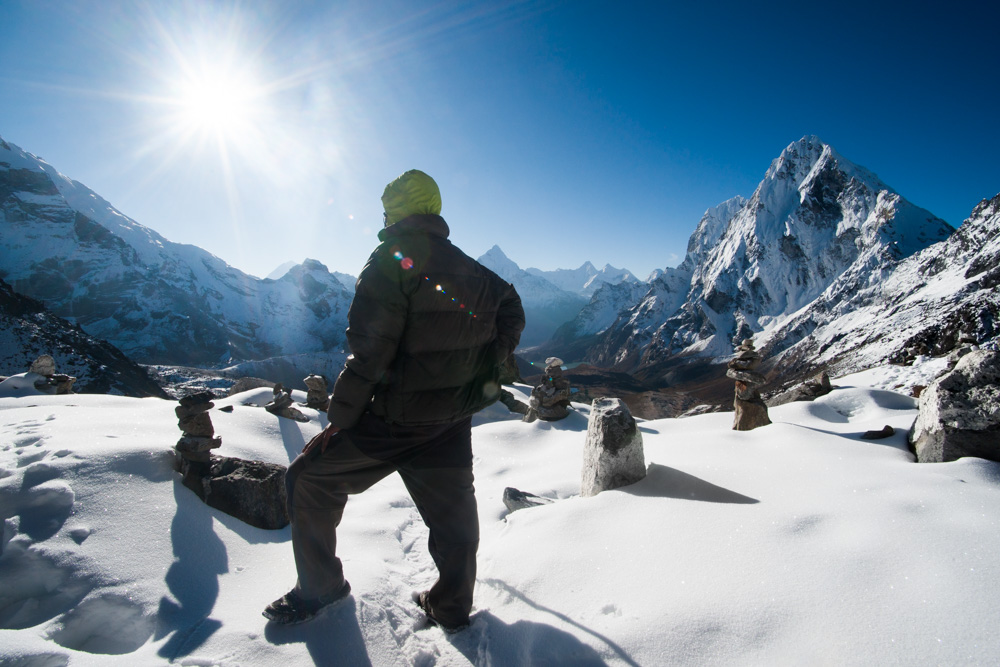
LABUJE PEAK CLIMB (6,119 m / 20,070 ft.)
- Home /
- Nepal /
- Peak Climbing & Expeditions /
- LABUJE PEAK CLIMB (6,119 m / 20,070 ft.)
The Lobuje Mountain consists of two different summits, viz. East and West with heights of 6,119 m and 6,145 m respectively. A continuous ridge connects them but there is still a sharp gap and a considerable distance between them. The East Peak is recognized as a trekking peak, whereas the West is known as an Expedition Peak.
Lobuje being an attractive mountain offers various existing routes and also a potential for new ones. The dark triangle of its rocky East face rises over the moraines of the Khumbu Glacier to a spectacular skyline, forming the south ridge.
The peak of Lobuje East is reached by descending a marked notch and climbing steep snowy slopes to the top. On most occasions, the mountain is climbed on the summit ridge only as far as a subsidiary snow summit, south?east of the true peak and before the notch. This peak is identified as the false peak. Laurence Nielson and Ang Gyalzen Sherpa made the first ascent to Lobuje East on 25 April 1984 although there are possibilities that others have reached the summit before. But no records are available.
Itinerary In Detail
-
1: Arrive in Kathmandu (1,400 m / 4,592 ft.)
Upon arrival in Kathmandu’s Tribhuvan International Airport, meet Asiatic Roads representative, assist and transfer to the hotel. At the lobby welcome refreshments will be served and room check in assistance provided. You may rest and unwind for the remainder of the day.
Eve: Welcome dinner at a Nepali restaurant featuring cultural program.
Overnight at hotel.
-
2: Gear check and Orientation
Day is free in Kathmandu for rest, last minute shopping, gear check and Trek / Climb Orientation in Kathmandu.
Dinner and overnight at hotel.
-
3: Fly to Lukla (2880 m /9,446 ft.) & Trek to Phakding (2652 m /8,698 ft.) – 3 hrs
The flight from Kathmandu to Lukla (2880m) with snowline of the Himalayan Range in the north and the rugged landing in the Lukla airport is said to be one of the most spectacular in the world.
After a short break the trek starts by following the trail leading to the northwest direction, which ultimately descends to the riverside settlement at Phakding (2652m).
Dinner and overnight at Phakding.
-
4: Trek to Namche Bazaar (3447 m /11,306 ft.) - 5 hrs
Follow the Bhote Koshi through the forest and pasture land, along the valley dotted small Sherpa settlements. Cross the Bhote Koshi and climb steeply, along switching back trail, lies the large Sherpa village of Namche Bazaar. Near half way point, view of Everest (8,848 m) and Lhotse (8,511m) come into sight. This prosperous town is largest in Khumbu. Mt. Thamserku (6,648m) and Kwangde Ri (6,624 m) loom along the east and west of the village. The sacred mountain Khumbila (5707 m) dominates the skyline along the west. Duration of trek = 6 hours.
Dinner and overnight at Namche.
-
5: Rest day at Namche Bazaar (3447 m /11,306 ft.)
To assist with the process of acclimatization, a day is spent in Namche. Visit the surrounding areas. Energy permitting you may traverse to Syangboche or even the twin villages of Khunde and Khumjung and return back to Namche for the night.
Dinner and overnight at Namche. -
6: Trek to Tengboche (3867 m / 12,683 ft.) -5~7 hrs
After breakfast, we start our trek to Tengboche. We pass through Rhododendron, Birch tree forest with magnificent views of Amadablam, Thamserku and Kangtega Himalayan ranges. Later as we walk we descend through the rhododendron forest, watching blood pheasant and Imphean pheasant. As we reach the valley there is Imja Khola (river) where we stop for a lunch at Phunki (3,200m/10,500ft), next to several large water driven prayer wheels. The afternoon is spent climbing slowly on a steep trail to the Tengboche Monastery, which is one of the most beautiful places on earth. Thyangboche lies at the base of Kangtega and is in a classic setting with superb views backs up the valley to the Ama Dablam, and the Everest poking its southwest face over the huge ridgeline linking Nuptse and Lhotse. One can witness the rear and beautiful west face of the Thamserku (6,608m/21,680ft) and Kang Taiga (6,685m/21,940ft). Late afternoon visit Tengboche Monastery, which is one of the most important and ancient monasteries in Khumbu Region. It is a traditional place where all Everest Expeditions receive their blessings as they walk towards the base camp
Dinner and overnight at Tengboche.
-
7: Trek to Dingboche (4350 m. /14,880 ft.) - 5 hrs
After breakfast, set out on the trail with a short, steep and muddy descent through a forest of birch, conifer and rhododendron to the meadows of Devouche. Continue on a level trail trough forests to arrive at a suspension bridge high above the fast flowing Dudh Kosi River with fine views of Mt. Amadablam. Cross the suspension bridge and climb for another 10 minutes to arrive at a resting place. Continue to climb to a pass and then there is a gentler walk to the village of Thyangboche (3985m), which also has a monastery. The monastery lies more on the route to Phortse and is not easily reached from the lower trail and for those who desire to visit the monastery, the trail bifurcates just before the village after the pass and a hard half hour of climb up the ridge brings one to this fabled monastery. At the monastery is housed the Scalp of the Yeti which traveled the world in the 60’s.
After lunch, pass through this village and take the right hand trail through the front yard of a few herders’ huts, over a stonewall. The landscape becomes very interesting as the vista opens before us and we can see the river flowing far down below as we take the trail that has been cut out along the sheer cliffs of rocks. A further, 40 minutes of walking brings us to the upper Pangboche Village from where there is a very steep climb to the ridge before descending to Khumbu Khola. Cross the bridge on a wooden bridge and from the bridge it is a 20-minute walk, usually in fierce winds to the valley of Dingboche.
Dinner and Overnight at Dingboche.
-
8: Dingboche – acclimatization day.
As per the study on high altitude sickness, it has been found that most of the people suffer or show signs of Acute Mountain Sickness (AMS) from the altitude of 14,000 ft. Thus it is highly recommended to have a rest day to acclimatize at this altitude before starting an ascent.
Dinner and overnight at Dingboche.
-
9: Trek to Lobuche (4931 m /16,173ft.) - 4 hrs
An ill- defined track traverses across to join the main trail coming up from Pheriche. On the way you can watch the beautiful view of the Mt. Cholatese (6,442m) back on the Westside of the route and Mt. Amadablam to the rear. After arrival at the ridge, descend, for about ten minutes, cross a bridge and arrive at Thugla for a short break.
After Thugla, there is a very steep ascent for about one hour to the ridge where there is a Sherpa memorial in remembrance to those brave mountaineers who died during Expeditions.
Travel along the jumbled moraines and scattered rocks passing by the memorials of Rob Hall and Yasuko Namba and others who perished during the Mt. Everest disaster of 1996. The memorial chortens dots the skyline facing the mountains and overlooking the valley below. Further on the trail leads to the terminal moraine of the Khumbu Glacier with views of Pumori or Widow’s Peak in the foreground. The stark and the rugged beauty create almost a moonscape. The teahouse at Lobuche is reached for lunch, after another hour of steady trekking through the moraine and is situated in a windswept valley with the views of the Tawatse (6,501m) and Nuptse (7,855m).
Dinner and overnight at teahouse lodge.
-
10: Trek to Gorakshep (5,160m) & Trek to Everest Base Camp (5,360 m / 18,000 ft).
From Lobuche, a short climb brings one to another valley. Travel along the Khumbu Glacier through the jumbled moraines and scattered rocks. The trail continues to slowly contour on the open landscape through an ablation and after about an hour, there is a steep ascent for about 20 minutes. Climb slowly to a ridge and then continue on a trail of rocks caused by rockslides. On a clear day Mt. Everest can be seen looming behind Nuptse. Arrive at the ridge above Gorakshep and then descend to Gorakshep, a settlement with 2 teahouses to stay overnight. This was the base camp for the 1952 Swiss Everest expedition. In 1953 A.D. the British Everest expedition called this “lake camp’. Gork Shep or “graveyard of the crows” has a small lake that is usually frozen and several monuments to climbers who have died during various Everest expeditions. The carved stone in memory of Jake Britenbach, US expedition and the monument of Indian Ambassador H. Dayal, who died during a visit to the Everest Base Camp after the 1965 A.D, Indian expedition, are northeast of the lake. – 3 Hours.
After lunch start trek towards Everest Base Camp (5,360 m / 18,000 ft.). The trip to base camp, while fascinating, is not spectacular as the ascent of Kala Pattar because there is no view of Everest itself from the base camp. Mt. Lhotse and Mt. Nuptse, which loom over the Base Camp, shades the view of Everest. The trail continues on a ridge from where a small glimpse of Mt. Everest can be seen. At the end of the ridge, a scrabbling descent leads to the entry into Khumbu Glacier. The trail through the glacier is an interesting one in that one can actually feel as if one is inside a fridge with the cold seeping from all sides. The Everest BaseCamp is also the site for the base camp for Lhotse and Nuptse. It is not actually a specific site as various expeditions have elected different locations for a semi-permanent camp during their assault on the mountains. Some of the sites that expeditions have used, as base camps are identifiable form debris on the glacier at 5360m or more.
However, the highlight of the trip to this place is the sight of the Khumbu icefall and the trek along the Khumbu Icefall is an interesting and an exhilarating one. Later return to Gorakshep for dinner and overnight.
Overnight at Teahouse lodge.
-
11: Climb Kalapatthar (5,545 m / 18,190 ft.) & backtrack to Labuche.
Early wake up and take the left-hand side trail and head straight up the hill to Kala Pattar (5,545m) for views of Mt. Everest. The trek up to the top is an arduous one and takes about an hour and half to two to reach it. The morning is the best time to view Mt. Everest from this vantage point as the sun is behind the observer and directly on the mountains in front. The climb to the Kala Pattar though tough, is well worth it as the views from here are breathtaking. The giants of the earth are all around Pumori (7,145m), Everest (8,848m), and China’s peak Changtse (7,553m), Nuptse (7,855m), Lhotse (8,516m), Ama Dablam and many others. Later return to Gorakshep for breakfast.
After breakfast starts backtrack to Labuche which may takes around 2 hours. Rest of the day is free for rest.
Dinner and overnight at teahouse lodge.
-
12: Climb to High High Camp (5,510 m / 18,072 ft.)
After breakfast, we push to high camp. Today is short walk over the moving rock. We have not fix the rope. In the afternoon spend some time for training by Climbing Leader / Sherpas. Rest of the day is for rest and acclimatization. We will sleep early and start for final summit push early next day.
Dinner and overnight at Camp.
-
13: Summit Labuje East (6,119 m / 20,070 ft.) & Descend down to Base Camp (5,010 m / 16,432 ft.)
We start final summit push very early today between 1 Am to 2 Am. After summit descend down to Base Camp at an altitude of 5,010 m / 16,432 ft.
Dinner and overnight at Camp.
-
14: Contingency day.
Contingency day in the event of any delays due to weather or health condition.
Overnight at lodge or in a Camp.
-
15: Backtrack to Devouche.
After the successful summit of Labuje Peak, starts backtrack to Devouche via Pheriche and Pangboche village. You will be happy to be back in warmer place.
Dinner & overnight at Lodge.
-
16: Backtrack to Monjo Village via Namche Bazaar.
After breakfast, starts backtrack to Namche Bazaar for lunch. After lunch continues descend down to Monjo village.
Dinner and overnight at Lodge.
-
17: Backtrack to Lukla.
After breakfast starts backtrack to Lukla via Phakding. It is interesting to watch others starting enthusiastically on the trek ahead. From Phakding, it is a surprising hard uphill climb to Lukla, which should take about 3 hours. It is a delightful ending to the trip as one enters into this busy village and our lodge in Lukla
Dinner and overnight at Lodge.
-
18: Fly to Kathmandu
Early morning, fly from Lukla to Katmandu on a twin Otter. Upon arrival, meet, assists and transfer to the hotel. Rest of the day is free.
Overnight at hotel.
-
19: Contingency day.
Contingency day in Kathmandu in case of any delays. Lukla flights are subject to weather permitting. There is an occasional risk of flight getting delayed or cancelled. It is better to have an extra night in Kathmandu for a backup.
Eve: Group farewell dinner.
Overnight at hotel.
-
20: Final departure
Free until final departure transfer to Kathmandu’s International Airport.
20 Days From

Any Question?
Feel free to call our travel experts.
+977 9851189018, +977 9801089018
info@asiaticroads.com
20 Days From

Any Question?
Feel free to call our travel experts.
+977 9851189018, +977 9801089018
info@asiaticroads.com
20 Days From

Any Question?
Feel free to call our travel experts.
+977 9851189018, +977 9801089018
info@asiaticroads.com
Reviews
In my 2 week stay, John was very professional and took me around to experience all that Kathmandu and surrounding areas has to offer. Sites were seen and many locals were met through John’s network.

Steven Stone
TravellerIn my 2 week stay, John was very professional and took me around to experience all that Kathmandu and surrounding areas has to offer. Sites were seen and many locals were met through John’s network.

Steven Stone
Traveller20 Days From







